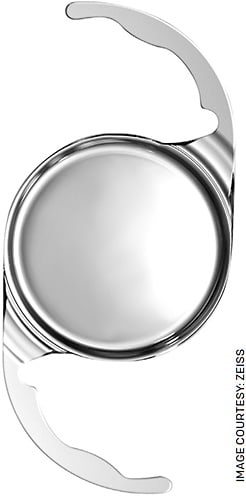ZEISS CT LUCIA 621P can benefit a wide variety of patients.
Although premium IOLs attract a lot of attention, monofocal lenses remain a stalwart of cataract surgery. For surgeons looking for a high-quality, stable monofocal lens that can provide excellent outcomes in a wide variety of patients, the aspheric single-piece 621P may provide an excellent solution. ZEISS announced the FDA approval of the IOL in April 2023.
The CT LUCIA 621P hydrophobic acrylic monofocal IOL features the ZEISS Optic (ZO) Asphericity Concept. This concept, according to the company, is designed to compensate for a wide range of spherical aberrations while also optimizing visual outcomes if there is decentration or lens misalignment. The lens is available in powers ranging from 0.0 to +34.0 in 0.5-D steps. It is the first broad market monofocal IOL from ZEISS to enter the US market as part of the ZEISS Cataract Workflow.

WIDE VARIETY OF USE
The CT LUCIA 621P enables surgeons to treat a wide variety of patients, says Steve Schallhorn, MD, chief medical officer for ZEISS Medical Technology. “It was carefully designed to provide the best vision for the wide variation that naturally occurs in human eyes.” Indeed, the surgeons interviewed here emphasize the IOL’s excellent optics to patients.
Y. Ralph Chu, MD, founder and medical director, Chu Vision Institute, Bloomington, Minn., adds that the optics provide “forgiveness for decentration inside the capsular bag so it can actually be used in a wide variety of patients.” The lens’ aspheric design provides not only high-quality vision, but also an expanded depth of focus, Dr. Chu explains. “Patients experience not only good Snellen quality, but also they just have this general sense that they see better after surgery.”
The ZO asphericity design involves a combination of negative spherical aberration (SA) design centrally to adjust for positive central corneal SA and a more positive SA profile in the periphery of the IOL to increase tolerance to decentration, according to Nicole Fram, MD, managing partner of Advanced Vision Care, Los Angeles. This design allows for more tolerance in variable corneal anatomy and decentration of the IOL without a decrease in quality of vision, she notes.
In presenting the CT LUCIA lens to her patients, Dr. Fram tells them that the lens comes from a great company and has excellent optics. Dr. Chu also emphasizes the quality of the optics to patients.
Besides use for straightforward cases, the lens can be used for complex situations, Dr. Chu points out. If a patient has complications, such as capsular fibrosis over time or asymmetric shrinking of the capsular bag or pseudoexfoliation, “you can feel confident that the eye will not have a gross decline in IOL performance,” says Dr. Fram.
SIGNIFICANT STABILITY AND EASE OF USE
Beyond the ability to use the lens in a variety of patients, the CT LUCIA 621P provides notable stability within the capsular bag, offering a reinforced optic-haptic junction with step-vaulted C-loop haptics.1 The haptic, says Dr. Schallhorn, “is designed so that the contact that it has with the capsular bag is more robust. That means that the lens is going to be more stable in the bag to minimize tilt and decentration.2 It’s designed with the dimensions of the normal human capsular bag in mind.”
Dr. Chu says the lens is the most stable single-piece acrylic lens that he has used. “I was amazed the first time I used it when I was removing viscoelastic at the end of the case, how stable the lens was inside the capsular bag, especially for a single-piece acrylic lens,” says Dr. Chu. At the time of viscoelastic removal, “this lens did not jiggle around, did not propeller inside the capsular bag.”
Dr. Fram adds that the stability may be attributed to the broad and step-vaulted haptic design. With some IOLs, she explains, when the viscoelastic is removed from the eye, the IOL will bounce around, “and you can see that there may not be a tremendous amount of stability.” However, the step vaulting of the haptics and the broad optic-haptic junction of the CT LUCIA 621P mean that “in surgery, it often feels like there’s better contact with the IOL optic and haptics within the capsule bag adding to stability once the viscoelastic is removed.
A preloaded single-handed injector assists with ease of use. The plunger-type injector, according to Dr. Fram, helps free your other hand to assist the trailing haptic into the bag using a second instrument through the side port. The silicone plunger can also be used to deliver the trailing haptic into the capsule bag. Although there is some increased resistance with the broader haptic design, she notes, the insertion is generally well controlled, allowing for smooth lens insertion into the bag.
DELIVERING ON THE PROMISE
The first time Dr. Fram used the CT LUCIA 621P, the patient reported seeing incredibly well postop. “It’s not always easy to be enthusiastic about another monofocal IOL with theoretical performance data, but this IOL is actually delivering,” for this patient and many more, says Dr. Fram. “When you implement a new technology and it matches what the clinical trials have shown and it matches the superb optics of what it’s promised, it’s very exciting as a surgeon.” OM
Dr. Fram is a consultant for ZEISS.
Dr. Chu is a consultant for ZEISS.
REFERENCES
- Borkenstein, AF, Borkenstein, EM. Geometry of acrylic, hydrophobic IOLs and changes in haptic–capsular bag relationship according to compression and different well diameters: A bench study using computed tomography. Ophthalmol Ther. 2022;11:711–727.
- Borkenstein AF, Borkenstein EM, Luedtke H, Schmid R. Impact of decentration and tilt on spherical, aberration correcting, and specific aspherical intraocular lenses: An optical bench analysis. Ophthalmic Res. 2022;65:425-436. Epub 2022 Feb 10.








